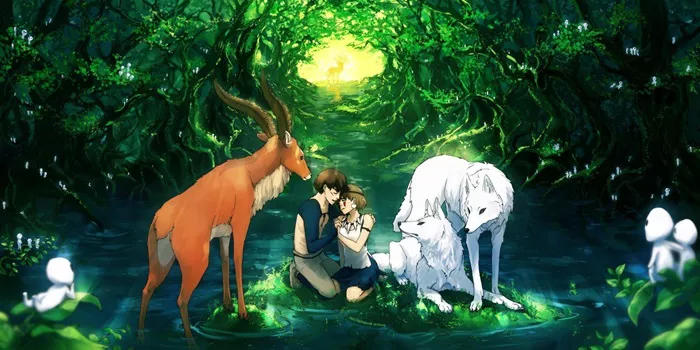In the realm of animated masterpieces, “Princess Mononoke” stands as a towering monument, captivating audiences with its mesmerizing storytelling, breathtaking visuals, and profound themes. However, behind this cinematic gem lies a team of visionary artists and creators who brought “Princess Mononoke” to life. In this article, we delve into the depths of the creative process behind “Princess Mononoke” and explore the individuals who crafted this timeless classic.
The Maestro Behind the Curtain: Hayao Miyazaki
At the helm of “Princess Mononoke” stands one of the most celebrated figures in the world of animation: Hayao Miyazaki. Renowned for his unparalleled storytelling prowess and imaginative world-building, Miyazaki’s influence permeates every frame of the film. As the director and one of the principal writers of “Princess Mononoke,” Miyazaki infused the narrative with his trademark blend of fantasy, environmentalism, and humanism.
Born on January 5, 1941, in Tokyo, Japan, Miyazaki’s journey into animation began at an early age. His fascination with manga and animation eventually led him to join Toei Animation, where he honed his skills as an animator and director. Over the years, Miyazaki’s distinctive style and thematic preoccupations would come to define Studio Ghibli, the renowned animation studio he co-founded with Isao Takahata in 1985.
The Collaborators: Studio Ghibli
Behind every great filmmaker stands a dedicated team of collaborators, and Miyazaki found his creative soulmates at Studio Ghibli. Established as a beacon of artistic excellence in the world of animation, Studio Ghibli boasts a roster of immensely talented artists, animators, and storytellers who played integral roles in the creation of “Princess Mononoke.”
One such collaborator is Toshio Suzuki, the esteemed producer who co-founded Studio Ghibli alongside Miyazaki and Takahata. Suzuki’s keen eye for talent and unwavering support played a crucial role in bringing “Princess Mononoke” to fruition. Additionally, the film benefited from the contributions of animators such as Yoshifumi Kondo, who served as the supervising animator and played a pivotal role in shaping the film’s visual style.
The Visual Poetry: Animation and Art Direction
Central to the allure of “Princess Mononoke” is its stunning animation and meticulous art direction. The film’s visual landscape is a testament to the unparalleled craftsmanship of its animators and art directors, who painstakingly brought Miyazaki’s vision to life.
Kazuo Oga, the film’s art director, deserves special recognition for his breathtaking work in crafting the film’s rich and immersive world. Oga’s masterful use of color, texture, and detail imbues every frame of “Princess Mononoke” with a sense of wonder and enchantment. From the lush forests of the Emishi village to the foreboding depths of Iron Town, Oga’s artistry transports viewers to a realm where the natural and the supernatural collide in a symphony of visual poetry.
The Voices of the Characters: Casting and Performance
No animated masterpiece would be complete without a talented cast to breathe life into its characters, and “Princess Mononoke” boasts a stellar ensemble of voice actors who delivered unforgettable performances.
Leading the cast is Yoji Matsuda, who lends his voice to the film’s enigmatic protagonist, Ashitaka. Matsuda’s portrayal captures the character’s courage, compassion, and inner turmoil with nuance and depth, anchoring the film’s emotional core. Opposite him is the fiercely independent San, voiced by the incomparable Yuriko Ishida. Ishida’s performance imbues San with a sense of fierce determination and vulnerability, elevating her character into a symbol of strength and resilience.
Themes and Messages: Environmentalism and Humanity
At its core, “Princess Mononoke” is a powerful meditation on the delicate balance between humanity and nature. Through its rich tapestry of characters and themes, the film explores the consequences of greed, industrialization, and environmental destruction, urging viewers to reconsider their relationship with the natural world.
Miyazaki’s deep-seated environmentalism is evident throughout the film, as he depicts the devastating impact of human greed on the pristine forests and mythical creatures of the ancient world. Yet, amidst the chaos and destruction, “Princess Mononoke” also offers a glimmer of hope, highlighting the potential for redemption and harmony through empathy, understanding, and compassion.
Legacy and Impact
Since its release in 1997, “Princess Mononoke” has left an indelible mark on the world of animation and cinema, inspiring generations of filmmakers, artists, and audiences around the globe. Its timeless themes, breathtaking visuals, and universal messages continue to resonate with viewers, cementing its status as a true masterpiece of the medium.
As we reflect on the creative genius behind “Princess Mononoke,” it becomes clear that the film’s enduring legacy is a testament to the power of collaboration, imagination, and storytelling. From Hayao Miyazaki’s visionary direction to the artistry of Studio Ghibli’s talented team, “Princess Mononoke” stands as a shining example of the transformative potential of animated cinema.
Conclusion
In the annals of animation history, “Princess Mononoke” stands as a crowning achievement, a timeless testament to the boundless creativity and imagination of its creators. From the visionary genius of Hayao Miyazaki to the meticulous craftsmanship of Studio Ghibli’s artists and animators, every aspect of the film reflects a dedication to excellence and a passion for storytelling.
As we celebrate the legacy of “Princess Mononoke,” let us not only marvel at its stunning visuals and captivating narrative but also recognize the profound themes and messages that continue to resonate with audiences to this day. In a world that is constantly evolving, “Princess Mononoke” serves as a poignant reminder of the enduring power of art to inspire, enlighten, and unite us all.

